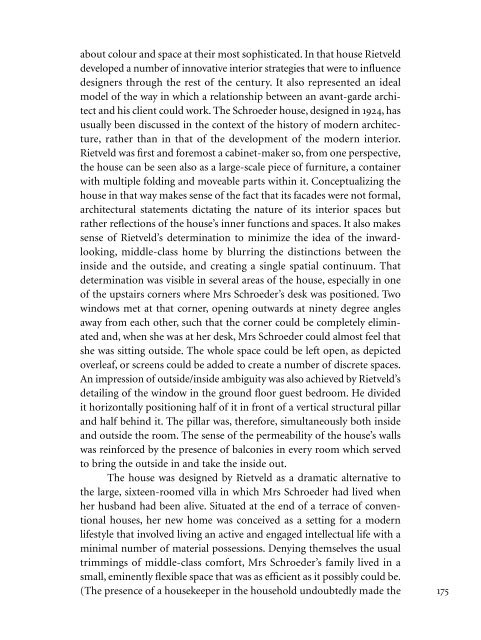You also want an ePaper? Increase the reach of your titles
YUMPU automatically turns print PDFs into web optimized ePapers that Google loves.
about colour and space at their most sophisticated. In that house Rietveld<br />
developed a number of innovative interior strategies that were to influence<br />
designers through the rest of the century. It also represented an ideal<br />
model of the way in which a relationship between an avant-garde architect<br />
and his client could work. <strong>The</strong> Schroeder house, designed in 1924, has<br />
usually been discussed in the context of the history of modern architecture,<br />
rather than in that of the development of the modern interior.<br />
Rietveld was first and foremost a cabinet-maker so, from one perspective,<br />
the house can be seen also as a large-scale piece of furniture, a container<br />
with multiple folding and moveable parts within it. Conceptualizing the<br />
house in that way makes sense of the fact that its facades were not formal,<br />
architectural statements dictating the nature of its interior spaces but<br />
rather reflections of the house’s inner functions and spaces. It also makes<br />
sense of Rietveld’s determination to minimize the idea of the inwardlooking,<br />
middle-class home by blurring the distinctions between the<br />
inside and the outside, and creating a single spatial continuum. That<br />
determination was visible in several areas of the house, especially in one<br />
of the upstairs corners where Mrs Schroeder’s desk was positioned. Two<br />
windows met at that corner, opening outwards at ninety degree angles<br />
away from each other, such that the corner could be completely elimin -<br />
ated and, when she was at her desk, Mrs Schroeder could almost feel that<br />
she was sitting outside. <strong>The</strong> whole space could be left open, as depicted<br />
overleaf, or screens could be added to create a number of discrete spaces.<br />
An impression of outside/inside ambiguity was also achieved by Rietveld’s<br />
detailing of the window in the ground floor guest bedroom. He divided<br />
it horizontally positioning half of it in front of a vertical structural pillar<br />
and half behind it. <strong>The</strong> pillar was, therefore, simultaneously both inside<br />
and outside the room. <strong>The</strong> sense of the permeability of the house’s walls<br />
was reinforced by the presence of balconies in every room which served<br />
to bring the outside in and take the inside out.<br />
<strong>The</strong> house was designed by Rietveld as a dramatic alternative to<br />
the large, sixteen-roomed villa in which Mrs Schroeder had lived when<br />
her husband had been alive. Situated at the end of a terrace of conventional<br />
houses, her new home was conceived as a setting for a modern<br />
lifestyle that involved living an active and engaged intellectual life with a<br />
minimal number of material possessions. Denying themselves the usual<br />
trimmings of middle-class comfort, Mrs Schroeder’s family lived in a<br />
small, eminently flexible space that was as efficient as it possibly could be.<br />
(<strong>The</strong> presence of a housekeeper in the household undoubtedly made the 175



